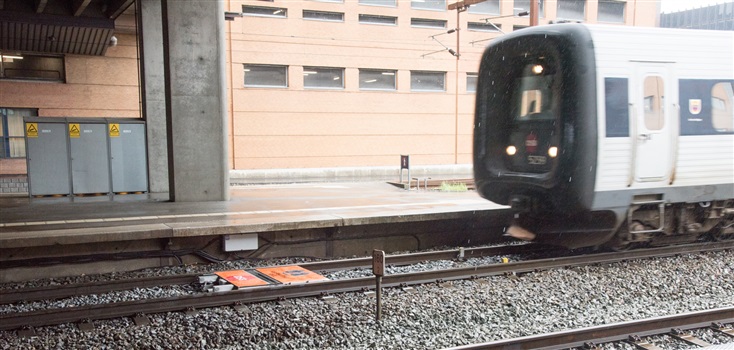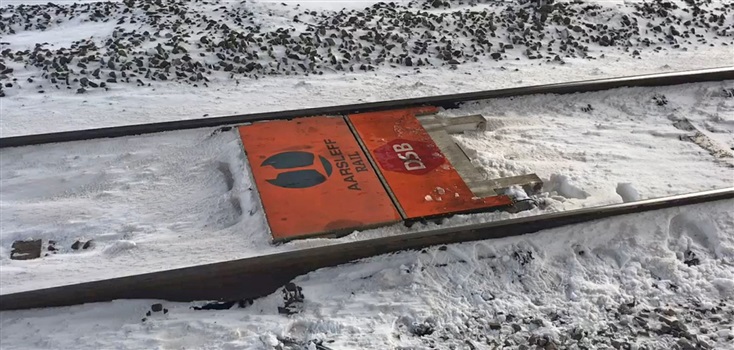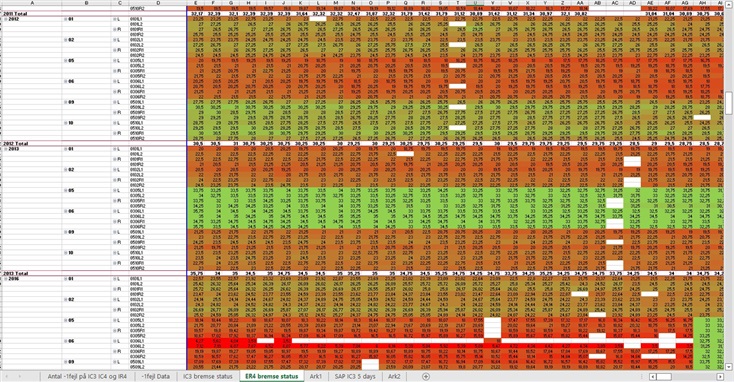Effective maintenance
with digital inspection
Danish version
Correct maintenance of trains contributes to punctuality, safety and economy – values that are important to any railway company. For DSB, the national train operator in Denmark, the small, orange casings between the rails at several locations in Denmark are an important tool in the maintenance process. The casings contain a system from Aarsleff Rail that measures wear on the brakes of passing trains.
Cameras and algorithms
Placed in the protective casing between the rails are six cameras. When a train approaches, a guard plate slides away, and the cameras scan the brake linings of the carriages as they pass. The system reacts so quickly that the train can pass at a speed of up to 60 km/h.
An algorithm analyses the images and calculates wear on the brake pads with an accuracy of 1/10 mm. With RFID tags at each end of the train, the system knows exactly which bogie it is scanning and where the worn pads are located. The system sends a continuous stream of information to DSB's maintenance system every time a train passes one of the ABI installations.
Constant development
DSB’s first automatic brake inspection systems (ABI systems) were installed in 2005 and could only handle trains at low speed. When the second generation was introduced in 2011, measurement accuracy increased. At that time a few ABI installations, located directly at the maintenance centres’ low-speed tracks was enough to meet DSB's requirements.

The ABI-scanner is fitted in a slim protective casing easily fitted between the rails in any standard gauge main track. Different brackets allow installation on any type of sleeper. Image: Aarsleff Rail.
New traffic patterns in 2018 resulted in a need for inspection of the brakes away from the maintenance centres. "We had to find both a new solution for the location of the scanners and a supplier of new ABI scanners", says Rasmus Østergaard, head of business development at DSB. "Aarsleff Rail could offer a system that facilitated inspection at train speeds up to 60 km/h. Thus, we could locate the inspection systems in the main track close to stations. With 2 ABI scanners in Odense and 1 in Kolding, most of our trains pass over at least one scanner every week," says Rasmus Østergaard.
Undercarriage scanning as a starting point
The inspiration for the ABI system came from systems for scanning of the underside of cars. These systems have typically been developed for security purpose, where the aim is to detect unwanted objects at the underside of a car. Unlike the scanning systems for cars, the ABI system is equipped with more advanced software, which can measure the thickness of the brake lining and notify when a lining has reached a predetermined target for replacement.
"It was an exciting process to advance from the first generation with an accuracy requirement of 1 mm at 15 km/h via the second generation with a stricter accuracy requirement of 0.1 mm to the current third generation with 0.1 mm accuracy and a speed of up to 60 km/h" says Jan Tanggaard, "the biggest task was to develop a casing for the third generation that could withstand the force of a passing train at speeds of up to 180 km/h". The casing also had to withstand Danish weather conditions and be self-cleaning. "Access for cleaning in the track is difficult and expensive and our customers expect a solution that take care of itself", says Jan and continues: "we have now through 3 years documented that our installation only needs to be removed from the track once a year for thorough cleaning and inspection”.

The casing provides protection from all types of weather and physical impacts from passing trains. Protected from damage, the automatic brake inspection system’s reliable functioning and uninterrupted data stream is assured. Image: Aarsleff Rail.
Low error rate through fine-tuning
As with all new technology, adjustments were needed when the ABI system had to be installed. "We started with a prototype from Aarsleff Rail in track 5 at Odense railway station," says Jørgen Søgaard Jensen, who as equipment manager at DSB oversaw the implementation of the three new scanners of the 3rd generation. “The first scanner was taken out of the track a few times before the camera settings were optimized. As expected, trouble shooting was concentrated to small ‘easy’ disciplines, such as getting reliable signals from wheel sensors for position and speed measurement of incoming trains, and the cleaning system, with sprinkler and wiper system," says Jørgen Søgaard Jensen. After a few months of fine-tuning, the first scanner worked satisfactorily, and the next 2 scanners could be installed to the same settings. Since spring 2021, all 3 scanners have operated with a very low error rate.
IT-Integration
In order to achieve optimum benefit from the inspection systems, DSB involved its IT organization in the process. First, a simple workstation was attached to the individual scanners, located next to the track where the scanner was located. To increase efficiency, DSB then established a connection to the maintenance system, which is operated on an SAP platform. This allowed work orders to be printed automatically for the workshop staff. As an added benefit, the solution was integrated with the spare parts management system. Today, both second and third generation scanners are operated on the same platform in DSB’s maintenance system.
Data harvesting potential
With around 120,000 brake lining measurements per day, the ABI system generates a large amount of data on the quality and development of the linings. DSB’s technical specialist, Niels Lykke Riis Rasmussen, monitors the ABI system's quality regarding stability and measurement accuracy. The measurements are recorded in a system where colour codes mark the condition of each individual brake lining.
"On the screens, I can easily follow the actual brake lining condition. A worn lining shows up as red, while a green colour indicates a new lining", says Niels Lykke Riis Rasmussen. "The colours are scaled from those 2 extremes allowing us to follow each lining as it wears. Normal wear on a brake lining causes a slow colour progression over several weeks. If I see rapid colour changes in the scale, it is something we need to investigate more closely," says Niels Lykke Riis Rasmussen. However, irregularities of this type are quite rare and on average less than 0.4%.

Screen shot showing the slow colour change over time, indicating a normal, predictable wear on the
brake linings. Each cell clearly shows the precise measurement for a particular brake lining on a specific train set. Image: DSB.
From reactive to proactive maintenance
DSB fleet manager Niels Kloppenborg, responsible for the company’s IR4 trainsets, is constantly looking for ways to optimize the fleet: "With data from the ABI system on the thickness of the linings, errors in the train's braking system can be easily detected. If we compare the wear of 2 sets of brake linings on the same axle and see different wear patterns, it is a clear indication of a leaking brake cylinder, says Niels Kloppenborg. “This type of analysis helps us to move from reactive, ‘correction of faults’ to proactive maintenance before failure arises, thus saving valuable workshop time and increasing the trains' operating time to the benefit of our passengers. We are currently implementing this analysis in the software of the ABI system, as a fully automatic function” Niels Kloppenborg concludes.

Illustration showing the comparison DSB uses to recognize a faulty brake cylinder. The 2 diagrams show left and right brake lining wear on the same axle. The right brake lining is showing almost no wear, indicating that the right brake cylinder on the axle is not working as much as the left. A clear indication of a faulty brake cylinder. Image: DSB.
Proven product with individual customization
Traditional manual measurements are today replaced by sensor technology and processes with much greater accuracy performing 365 days a year without interruption. "With the increasing use of artificial intelligence, we are well on our way to self-thinking systems", says Jan Tanggaard, senior developer at Aarsleff Rail. "We combine known and tested techniques and components from industrial automation to a tailored solution for the customer for each individual inspection task. In this way, we provide our customers the possibility to switch to proactive maintenance, instead of condition-based maintenance", says Jan. Over the years, Aarsleff Rail has accumulated extensive experience in development of brake inspection systems in close cooperation with customers and end users. "The experience from the different generations of ABI systems means that we are able to offer high performance systems adapted to the requirements of the individual railway operator," Jan Tanggaard concludes.
